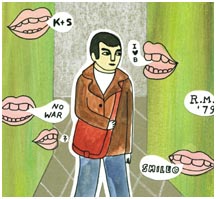To read our exclusively online On the Campus column, click here.

Illustration: Martina Witte |
April 7, 2004: On the Campus
The walls do talk
By Tom Hale ’04
As everyone knows, it costs money to name something at Princeton. From Frist, to Forbes, to Firestone, to Fisher, the campus reads like a list of Annual Giving all-stars, a brick and mortar testament to the generosity of alumni.
Then there is BCK ’79. As far as I can tell, BCK ’79 never donated so much as a desk or a doorknob, but he or she did leave one indelible mark on the University — a fine rendering of his or her initials and class year on the wall of my carrel in Firestone.
An official “naming opportunity” — as the development office terms it — may cost a small fortune, but unofficial immortality costs little more than a pen or a pocketknife and a bit of chutzpah. For the graffitist, the whole campus is a naming opportunity.
Take my carrel, for example. In addition to BCK ’79, Unit B-13-H-4 has over the years been claimed in the name of “JM,” “Anne,” and one “Danimal,” who apparently “loves QB.”
Walking by the desks on the C-level of Firestone, one finds more calling cards of past Princetonians, such as “SFC ’99,” “KM ’00,” and “Benji K,” who proclaims himself the “Starcraft Master.” There is also a “WWB,” perhaps the calling card of Bill Bradley (William Warren Bradley) ’65.
However, the best archive of illicit inscriptions on campus is McCosh 50. Something about the great room — perhaps its sense of history, or its unforgiving wooden seats, or the sometimes less than titillating lectures delivered in it —drives students to doodling, and always has. One septuagenarian seat has borne witness to ’29, ’41, ’68, ’99, and ’02.
The phrase “if the walls could talk . . . ” is often invoked in such storied settings. In McCosh 50 the walls (and desks and seats) do talk, but, as comedian Mike Myers has wondered, “Are they really saying anything?”
It seems not. One chair happily wishes its occupant “MERRY CHRISTMAS” in big bold letters, illustrating the sentiment with a decked tree and a pile of presents. Another tends more toward abstract expressionism; its confused tangle of squiggles and strokes perhaps captures a frustrated student’s impressions of macro-economics. A third goes theological, declaring that “Len Quesnelle, Jim Ward, + Mike Bois” form a “Holy Trinity.”
Other Princeton graffiti carry a more profound — or at least clearer — meaning. For example, the men’s room by the Firestone entrance plays host to a pithy debate on current events. After one writer submitted that “Bush = war = death,” a respondent countered, “It’s cowardly attitudes like these that made WWII a reality.” Someone else noted that “cowardice does not cause wars,” which was confirmed by a fourth author, who reasoned, “True, it would quickly surrender.”
A fifth contributor drew an arrow to a ventilation duct and suggested that the Bush supporter might find the missing WMDs in there, “because they ain’t in Iraq.” A sixth pundit cautioned: “Do not awake the carnivorous opossum,” which presumably lived in the duct and would devour any weapons inspectors who tried to spelunk it.
In other cases, Princeton graffiti are devoted to satirical social commentary. An observant user of the B-floor men’s room noted between the wall tiles that “grout is here to stay.” The second entryway of Henry used to admonish passers-by: “New money sucks — get out of my yacht club!” When the Office of Information Technology posted an overenthusiastic notice that the Scully printer had been repaired (“The Scully Printer is Back!!!”), a resident sassed, “YESSS!!! Party over HERE!!!”
Then there are the official graffiti throughout the Frist Campus Center. Perhaps sensing that the campus population sought a more textual approach to interior design, the Frist decorators stenciled bold quotes from Princeton luminaries such as Aaron Burr and Toni Morrison onto the walls of the entryway. Three flights up, the theater invites students not only to “dance,” “sing,” and “perform,” but also to “pirouette,” “exhort,” and “gallivant.”
Of course, it might be objected that graffiti, while perhaps entertaining,
are nonetheless vandalism, and ought not to be encouraged. The rule book
is ambiguous on the issue, only stating, “Students who damage University
property will be subject to University disciplinary action.” But
one man’s damage is another’s artwork. Personally, I think
my rather bland carrel has only been enhanced by the contributions of
BCK ’79 and the others. ![]()
Tom Hale ’04, from Rhode Island, is a Woodrow Wilson School major.

